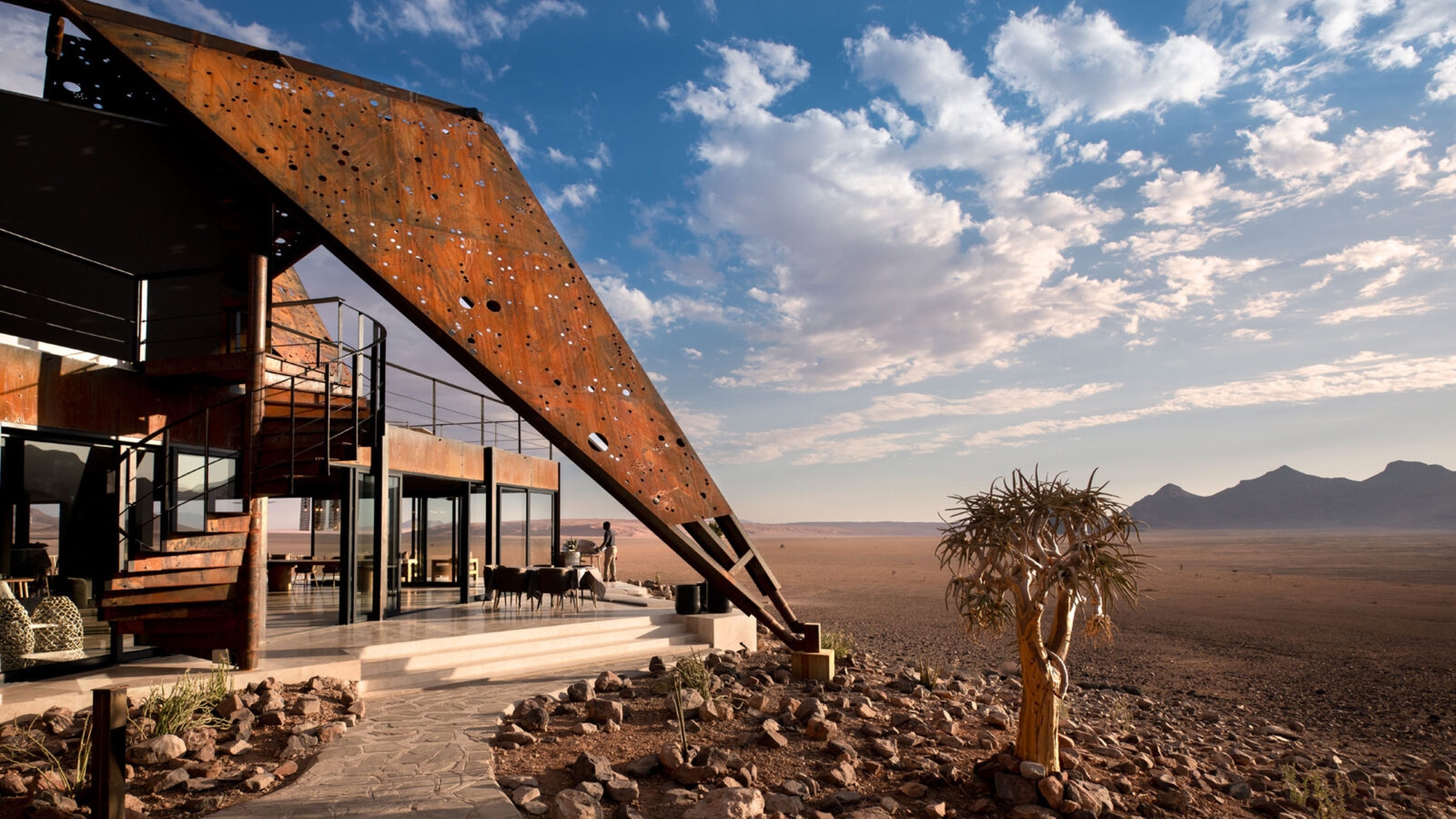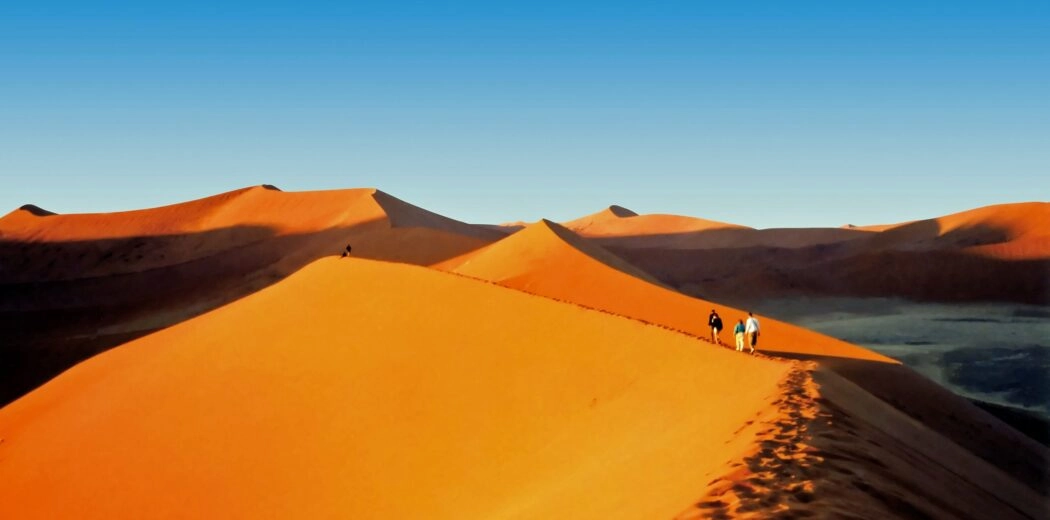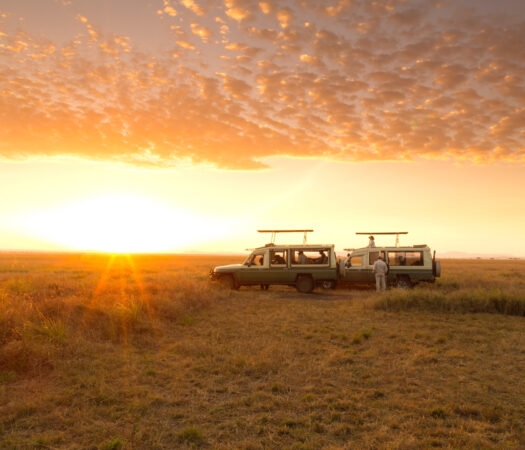Choosing where to stay in Namibia can feel like an adventure itself. Between the Namib and Kalahari deserts, the driest country in sub-saharan Africa will surprise you with varied and diverse highlights from wildlife safaris, scaling sand dunes, adventure activities, discovering ancient culture and much more.
Mysterious lunar landscapes and red swirling sands make Namibia feel like another planet entirely. A land of endless skies, great contrasts and wonderful adventures. There’s Sossusvlei, one of Namibia's most spectacular landmarks, remote escapades in the Kunene River region and elephants, lions and leopards in Etosha National Park. You can track rhino on foot and marvel at ancient rock art in Damaraland, before meeting Cape fur seals and spotting shipwrecks on the Skeleton Coast.
Best Places to Stay in Sossusvlei
Sitting below the towering red sand dunes you’ll find the area’s famous namesake; Sossusvlei, a blinding, bright white salt and clay pan, punctuated with ancient black trees, frozen in time.
Within the Namib Naukluft National Park, Sossusvlei is one of Namibia’s most popular destinations. The landscapes here are epic and the activities on offer are vast and varied from hikes to find ancient rock art paintings, adrenaline-filled quad bike rides and early morning ventures into the desert.
Wilderness Kulala and Wilderness Little Kulala
These two sister properties have a secret: a private gate to the sand dunes. The emphasis in Namibia tends to be on remote experiences, but Sossusvlei does draw the crowds. With exclusive access to the dunes you’ll head out to them earlier in the day, before everyone else, making your sunrise experience even more special.
Both camps have private access to over 27,000 hectares of pristine wilderness for you to enjoy your activities, and there really is something for everyone: gentle nature walks, drives, scenic sundowners, exciting quad bikes, fat wheeled bikes and night time scorpion walks. Try a hot air balloon ride and silently soar over the otherworldly dunes, landing in time for a champagne breakfast.
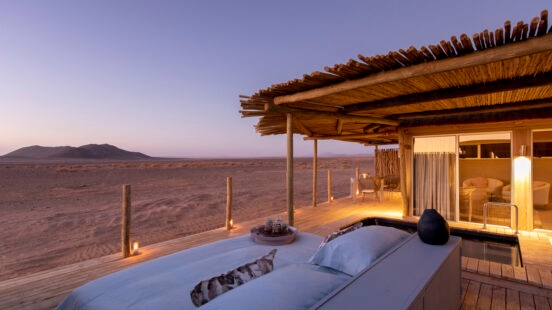
Wilderness Kulala is the big sister, working well for varied group sizes; couples, groups of friends or families. Wilderness Little Kulala, as the name suggests is a smaller, more intimate camp, each suite coming with a private plunge pool and rooftop deck. The rooftop is perfect for atmospheric sundowners and stargazing or even sleeping out with the sounds of the desert around you.

Sossusvlei Desert Lodge
Sossusvlei Desert Lodge is the epitome of style and sophisticated design. Secluded, private villas, built from stone and glass, all come with a private plunge pool and deck. Situated on the edge of the International Dark Sky Reserve the star gazing here is exceptional. Cleverly woven into the design of the rooms are retractable skylights so you can enjoy the twinkling canvas of stars from the comfort of your bed.

Take to the skies here on an exhilarating helicopter ride, twisting and turning in the air for the best views of the dunes and desert below. Step back in time to discover San rock art, dotted around the untamed desert, created by southern Africa’s oldest inhabitants, the San People.
Honeymooners and couples will revel in the romantic touches and tranquillity of Desert Lodge and with the two-bedroom star dune suite and wild child programme, families also fit right in.
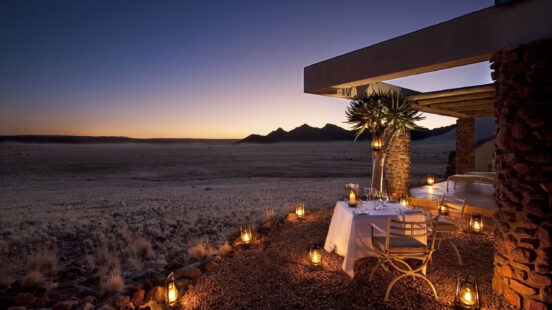
Best Places to Stay in Kunene River, Kaokoland
Kaokoland is made up of a series of mountain ranges, dry river beds and vast plains. They weave within one another, creating some of the most remote and hard to access areas in southern Africa. Lush vegetation, flowing rivers and snapping crocodiles contrast with the arrid, orange desert where gemsbok roam, their horns a flash of shining black against their sandy home. The Himba, Namibia’s last true nomads still farm and traverse this land. Much like the red herbal paste used on their skin and hair, their history and culture is rich and vibrant.
Wilderness Serra Cafema
Namibia’s inland experiences are characterised by a dry desert landscape; sand and rocks, mountainous or flat – it’s going to be dry. Wilderness Serra Cafema‘s riverside location makes it unique on our list of favourites. Sitting on the banks of the Kunene river, the only permanent water source in the entire region, you’ll find an oasis of vegetation cutting through the arid ochre desert.
This is Namibia’s most remote camp, situated on the 300,000 hectare Marienfluss conservancy, owned primarily by the Himba with a tiny population of around 350 people. Respectful interaction, learning about the Himba way of life, is something Wilderness Serra Cafema is proud to add to its roster of excursions which include boat trips on the river where you can try to spot Nile crocodiles lurking in the shallows.
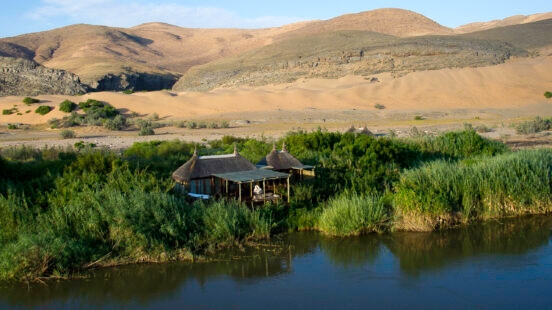
The accommodation here is comfortable, there’s even access to massage therapies, however there is an overriding sense of being off the grid. If you want to experience remote Namibia and to feel swallowed up by the land and skies, totally immersed in this place far away from home, then Wilderness Serra Cafema is for you.
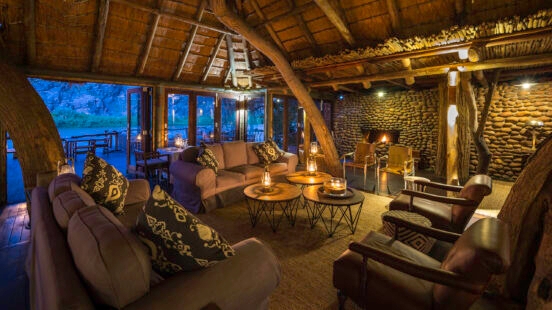
Best Places to Stay in Etosha National Park
No trip to east or southern Africa is complete without a traditional safari experience. There’s nothing quite like early morning game drives and late night waterhole viewing to make you feel completely immersed in nature. Mostly covered by an immense salt pan, the name Etosha means ‘great white area’, a perfect description of the bright white landscapes and intense cloudless skies.
Home to four of the Big 5 (there’s no water buffalo here) there’s plenty of opportunity for great wildlife sightings. You’ll find high densities of lions, elephants and plains game at the park’s famous waterholes during the dry season of May to October. As with many National Parks, Etosha is neighboured by private reserves with fencless borders where wildlife roams freely and the number of visitors is restricted. Ongava private reserve is our top pick, a 30,000 hectare wildlife haven committed to protection, restoration and reintroduction of wildlife.
Little Ongava
With just three luxurious hilltop villas, Little Ongava is the place to stay for a luxury safari. Complete with private pools, viewing deck, veranda, fireplace and epic views all around, you’ll feel like you’re on top of the world.
Located within the Ongava private reserve the main focus here is wonderful wildlife experiences.

As you’re within a reserve and not the national park, there’s a varied selection of activities: day and night time game drives, walking safaris, visits to hides overlooking waterholes and rhino approach walks on foot. The lodge’s proximity to Etosha National Park means you can enjoy the best of both worlds with game drives into the park itself.
Little Ongavas’s size means it’s a fun option for groups or families to stay in all together, with children as little as 3 years old welcomed here.

Best Places to Stay in Damaraland
Damaraland is the breathtaking mountainous region of Namibia. Huge mountains and rock formations loom out of the dry, dusty earth with imposing stature, creating dramatic landscapes in all directions.
Hundreds of species of birds can be found here along with large desert adapted mammals such as elephants, lions and rhinos, making for varied and vibrant wildlife excursions. It’s home to the UNESCO heritage site of Twyfelfontein where you’ll find one of Africa’s largest and oldest collections of rock engravings.
Wilderness Desert Rhino Camp
Wilderness Desert Rhino Camp is situated on the enormous 550,000 hectare Palmwag concession, protected by the Save the Rhino Trust. This intimate camp delivers genuine experiences and authentic safari-style living.
The critically endangered black rhino population here has quintupled over the past 30 years, an important achievement made possible with the support of Wilderness Desert Rhino Camp. A portion of all revenue made from the camp is fed back, not just the Save the Rhino Trust, but also local communities.

Birding enthusiasts will be in their element with many species to spot including the Verreaux eagle, soaring high over the rocky hillsides. Game drives and nature walks showcase the stunning wilderness while you search for desert adapted wildlife and the must-do excursion is the rhino tracking on foot. To see these enormous, yet fragile creatures up close, under the watchful and skilful eye of the Save the Rhino Trust guides is a once in a lifetime opportunity.
Anyone who cares deeply about conservation and the protection of rhinos should add Wilderness Desert Rhino camp to their list. Staying here is a meaningful experience filled with wildlife and adventure.
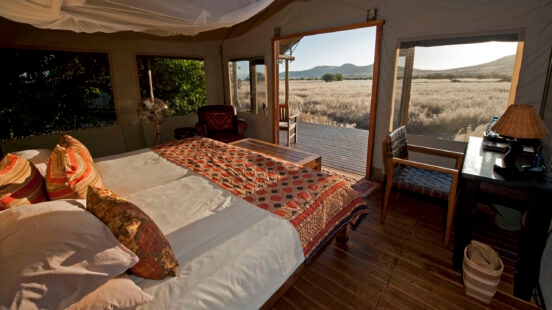
Wilderness Damaraland Camp
Namibia’s first successful community joint venture, Wilderness Damaraland Camp has a lot to be proud of. Adobe-style, thatched suites blend in with the surroundings which offer an unusual combination of wildlife and cultural experiences.
It’s breathtaking to see how wildlife flourishes in extremely dry conditions, adapting in many resourceful ways. Expect to see lions, cheetahs, giraffes, elephants and even black rhinos during your stay. The birding is exceptional with over 240 species to spot against the stark rust mountains that turn to purple as the sun sets. In the mountains and rock formations overlooking camp you’ll marvel at Africa’s largest and oldest collection of rock art carvings.

Namibia’s unique heritage can be explored here with positive engagement with the local communities; Nama-Damara, Herero, Owambo, and the displaced Riemvasmaakers of South Africa.
The range of activities here makes the camp suitable for anyone on a landscape and wildlife focused trip and who have a passion for learning. If history, culture and learning about local communities is important to you must make sure Widlerness Damaraland is added to your wish list.

Best Places to Stay in Skeleton Coast
The San call it ‘The Land God Made in Anger’, Portuguese sailors referred to it as ‘The Gates of Hell’ – it’s fair to say the Skeleton Coast can be pretty inhospitable. With strong currents, sand storms, fog and wild prevailing winds, finding bleached shipwrecks along the wide beaches is no surprise.
There is a lot more to this region than treacherous waters though. Going inland you can follow rivers, explore oases and rock formations, meet seals, birds and even big game.
Wilderness Hoanib Valley Camp
Wilderness Hoanib camp sits within Kaokoveld, close to the famed rugged coastline. An eco-friendly camp completely solar powered and a centre for research and conservation. The camp is run as a joint venture with neighbouring communities, making sure everyone can benefit from ecotourism.
Our favourite excursion here is the 4×4 trip to the Skeleton Coast to see the Cape fur seal colonies and shipwreck remains.

You’ll travel via the Hoanib river, the dune fields and the Klein oasis before taking a spectacular light aircraft flight back to camp with magnificent aerial views of the coast, dunes and desert.
This camp will suit anyone who is adventurous and has a desire to get off the beaten track. Birders and wildlife enthusiasts will be thrilled with the variation of excursions and visits to the research centre.

Our Top Namibia Example Trips
Still Looking for Inspiration?
Get in touch to start building your Namibia adventure.
